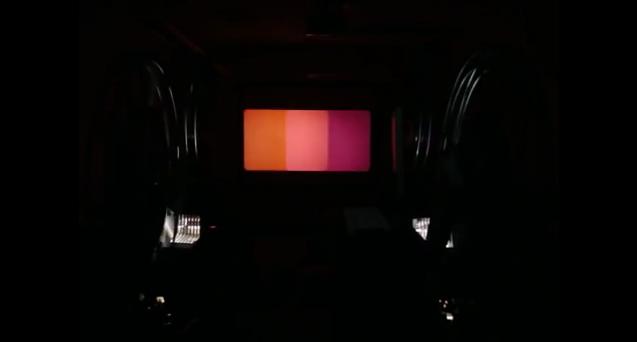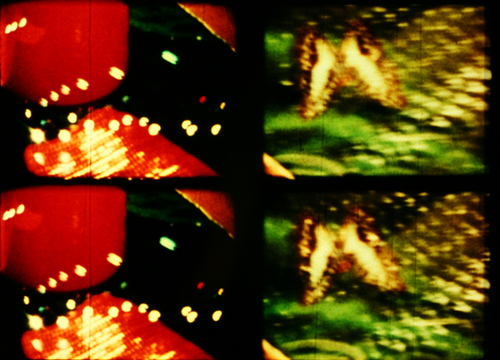
Double Screen, Double Frame and Double Projection in Expanded Cinema
Friday, May 30, 2014
Atlanta Contemporary Art Center
curated by Andy Ditzler
 |
2 x 16mm Double Screen, Double Frame and Double Projection in Expanded Cinema Friday, May 30, 2014 Atlanta Contemporary Art Center curated by Andy Ditzler |
 |
|
Paul Sharits, Shutter Interface (1975), double 16mm
projection with overlapping color frames |
Program:
Third Eye
Butterfly (Storm de Hirsch, 1968), 9 minutes
A Dance Party
in the Kingdom of Lilliput Nos. 1 and 2 (Takahiko Iimura, 1964/66), 13
min
Shutter Interface (Paul Sharits, 1975), 24 min
all works presented in 16mm dual projection
Like still
photography, a film camera creates the illusion of depth on the flat surface of
a film strip. But for this illusion to be experienced, a film projector
intermittently lights and magnifies successive frames on the film strip
twenty-four times a second and bounces the resulting light patterns off a
screen, creating the further illusion of motion from the strip of still images.
In this sense, any film work is completed by the act of projection. But
tonight's program features three works in which the film strip is not only
displayed but modified by projection, as part of the work. These dual projection
films – each requiring two simultaneously running 16mm projectors – exploit
doubling of the screen to address the many dualities inherent to cinema.
On January 27, 1966, a program of dual-projection works was presented at the
Film-Makers’ Cinematheque in New York, advertised in the Village Voice as
"double screen experiments by double screen experimentalists." The ad hoc nature
of this category notwithstanding, the screening actually presented two key works
of the newly emerging "expanded cinema." Andy Warhol's Outer and Inner Space
premiered that night in two 33-minute reels that were originally shot
sequentially, but projected simultaneously in adjacent frames on the screen.
Barbara Rubin's Christmas on Earth, also shown, featured a unique
exhibition method: instead of projecting side-by-side, one reel is projected
inside the other in superimposition. That event appears to have been Warhol's
very first foray into public double-screen projection; later that fall, he
premiered what is probably the best-known of all double-screen films, The
Chelsea Girls.
Tonight's screening features less-known works from
this era and after, which show how other prominent double-screen
experimentalists used dual projection as a conceptual and aesthetic system of
rich possibilities. In an era when both cinemas and galleries are standardized
for single-screen digital projection, works such as these are more rarely
screened than ever – yet they continue to hold fascination and possibilities
beyond their historical moment.
Despite increasing recognition of women
filmmakers in the context of 1960s underground cinema, the prominent films of
Storm de Hirsch have yet to receive sustained attention. A poet as well as
filmmaker, de Hirsch made films that attempt to expand the boundaries of both
cinema and consciousness, exemplifying the psychedelically inspired side of the
New York underground. Her descriptive note for Third Eye Butterfly
reads in part, "How can dust cover the arrows of light? How can darkness favor
oblivion in the face of light? The variations of soul-touch exist in the auras
of illumination. The Great Eye dominates."
Both title and description
reflect the main motifs seen in the film: light, imagery of drawn or printed
butterflies, flowers, a distinctive "third eye" title logo that appears
throughout the film – and not least, the kineticism of movement itself ("the
arrows of light"). In conjunction with the driving jazz percussion score, the
film is a dazzling experience.
de Hirsch apparently filmed on unslit 16mm
film intended for 8mm projection. In this process, half the film strip is
photographed with a 16mm camera, then is flipped to photograph the other side of
the strip, then is cut lengthwise into 8mm projection film by the lab. When left
unslit and projected as 16mm, the image is doubled both top to bottom and left
to right, producing a grid of four images (and eight images in double
projection). de Hirsch exploits this multiplicity, producing a variety of
kinetic movements across the grid pattern of imagery. de Hirsch constructs
another layer of doubling by superimposing one image over another in many of the
individual shots. Light is depicted as reflected off mirrored surfaces such as
mylar – a doubling of the process of projection, which reflects the light of a
film off the movie screen. Thus, Third Eye Butterfly itself mirrors the
process of film projection and viewing – embodying the self-reflective wisdom
suggested in its title.
Takahiko Iimura's A Dance Party in the
Kingdom of Lilliput is a short film separated into a number of fragmentary
sections depicting activities, some of them performed naked, by the Japanese
artist Sho Kazakura. The sections are arranged seemingly at random, each titled
with the letter "K" (for Kazakura and also Kafka's "Mr. K"), accompanied by
another random letter. (These single-lettered titles reinforce Iimura’s view of
the entire film as a species of concrete poetry.) Dance Party first
existed only as a single-screen film. In the dual projection edition, this
original version comprises the left half of the screen. At some point, Iimura
received a "bad print" of the film, apparently from the lab, and proceeded to
further damage not only the imagery (by hand-scratching the emulsion on the
print), but also the structure (by re-ordering the sections). This second,
damaged version is screened adjacent to the original (which Iimura originally
also intended to newly re-edit for each screening). In this way, the
double-screen version of Dance Party reflects relations between present
(the original version on the left suggests present time as a kind of "official"
experience) and future (the inevitable damage inflicted on projected prints, and
the concurrent re-splicing of experience) – a humorous acknowledgement of the
sometimes nerve-wracking process of film projection, as a metaphor for ongoing
time. Through its playful rearrangement of the alphabet and its disjunct
construction, the left-side original of Dance Party subverts our sense
of an ordered existence; and through the projection of the damaged version on
the right, it incorporates its own physical breakdown into the work, and wittily
transfers our anxieties about disorder to the screen.
Paul Sharits'
Shutter Interface (1975) was constructed as a four-projector gallery
installation work meant to be looped over the run of an exhibition; it is seen
here as a two-projector "economic" adaptation created by Sharits and limited to
twenty-four minutes. Both reels consist entirely of groups of color frames (red,
purple, pink, orange, yellow, blue) lasting from two to eight frames; each group
is separated by a single black frame. On each reel a high-pitched tone
accompanies each black frame. (The film subverts the idea of synchronized sound
and image by having sound only when the screen is blank.) The two reels'
soundtracks are stereo separated so that the left-right divide of the imagery is
reproduced in the room sound. The speed of the film frames is such that at
regular volume, the beeping sounds become a continuous, soothing counterpart to
the imagery, just recognizable as individual tones and in their linear totality.
Sharits gives two options for projecting Shutter Interface. For
the entirety of version A, the two screens overlap precisely, resulting in three
flashing color fields of equivalent size; the middle field necessarily contains
and combines whatever colors are being projected on the left and right reels.
Version B (which we will perform tonight) asks the projectionist to gradually
merge the images together over the course of the screening, following a graphic
diagram showing the two projectors’ positions over the duration of the film. In
this version, the film begins with the two frames completely separate and ends
with the two frames exactly superimposed. As version B of the film progresses,
it transitions from two independent color fields to one color field made up of
two interdependent parts. The individual frames can no longer be seen, only
their combination into a whole. Sharits claimed to have keyed the frame rates of
Shutter Interface to his own biological rhythms. This, together with
the projection technique of gradually merging frames, gives Version B resonant
political and emotional overtones – the relation of the individual to the
collective, the aesthetic to the political, and the personal to the universal.
Through its deliberate lack of development, Shutter Interface is
intended as a contemplative, meditative work; yet it also continuously engages
the viewer with a spectacular, subtle, seemingly endless array of color and
movement. At times the overlapping screens and colors suggest a graphic,
revolutionary "flag" for the kind of cinema Sharits intends, albeit a flag whose
rectangular borders are constantly shifting; at other times, such as when the
screens overlap completely, a gentler pulsation of color suggests distant
lightning. Any number of other interpretations are possible, but the real
subject of this film seems to be its own illusory motion. As Sharits announces
in his title, Shutter Interface is about the intermittent shutter
mechanism of the projector – the rotating blade which causes a given film frame
to blink on and off the screen and thus provide us with the central illusion
that drives motion pictures.
But what is motion in a film that contains
no movement? There is no photographed image of movement across the screen, or
into and out of depth. Rather, the color frames flash on and off, in
combinations nearly too fast to fully comprehend: the motion of consciousness,
via consciousness of motion – or, at least, its illusion. As nearly always in
Film Love shows, the projectors are in the room with the audience. As you watch
Shutter Interface, we encourage you to move among them, to view the
strip of images with its still color frames as it passes through the projector,
to be conscious of cinema's illusion even as we are enthralled by it. Film's
double illusions, motion and depth, are here illuminated by their absence (even
as the projectors multiply). As viewers, we supply the illusion – and in this
sense, Shutter Interface makes projectionists of us all.
Program notes 2014 Andy Ditzler
Thanks to MM Serra and Josh Guilford at
Film-Makers’ Cooperative, and to Atlanta Contemporary Art Center.
 |
| Storm De Hirsch, Third Eye Butterfly (1968) |
2 x 16mm
is a Film Love event, programmed and hosted by
Andy Ditzler for Frequent Small Meals. Film Love promotes awareness of the rich
history of experimental and avant-garde film. Through public screenings and
events, Film Love preserves the communal viewing experience, provides space for
the discussion of film as art, and explores alternative forms of moving image
projection and viewing. Film Love was voted Best Film Series in Atlanta by the
critics of Creative Loafing in 2006, and was featured in Atlanta Magazine's Best
of Atlanta 2009.